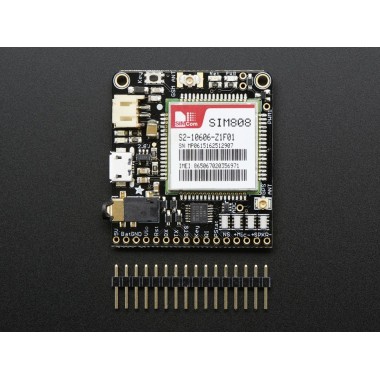Productos
Adafruit FONA 808 - Mini Cellular GSM + GPS Breakout

Mini GSM+GPS+GPRS, basado en el chip SIM808. Todo lo que puede hacer tu celular!
COD: D002542
Peso: 0.012 Kg
Disponibilidad: Sin Stock
ARS 162319.99
El producto no está disponible para la venta en este momento
Características
DESCRIPTION
Cellular + GPS tracking, all in one? Oh yes! Introducing Adafruit FONA 808 MiniGSM + GPS, an all-in-one cellular phone module with that lets you add location-tracking, voice, text, SMS and data to your project in an adorable little package.
This module measures only 1.75"x1.6" but packs a surprising amount of technology into it's little frame. At the heart is a powerfull GSM cellular module (we use the latest SIM808) with integrated GPS. This module can do just about everything.
- Quad-band 850/900/1800/1900MHz - connect onto any global GSM network with any 2G SIM (in the USA, T-Mobile is suggested)
- Fully-integrated GPS (MT3336 chipset) that can be controlled and query over the same serial port
- Make and receive voice calls using a headset or an external 32Ω speaker + electret microphone
- Send and receive SMS messages
- Send and receive GPRS data (TCP/IP, HTTP, etc.)
- PWM/Buzzer vibrational motor control
- AT command interface with "auto baud" detection
Here's the GPS specifications:
- 22 tracking / 66 acquisition channels
- GPS L1 C/A code
- Sensitivity: Tracking: -165 dBm, Cold starts : -147 dBm
- Time-To-First-Fix: Cold starts: 30s (typ.), Hot starts: 1s (typ.), Warm starts: 28s (typ.)
- Accuracy: approx 2.5 meters
Sounds delicious, right? So we plated this fine module onto a little breakout with all the extras you need to make your next project shine:
- Onboard LiPoly battery charging circuitry so you can take your project on the go. Use any 500mAh+ LiPoly or LiIon battery and recharge over the MicroUSB when necessary. Two LEDs let you know when its charging and done
- Standard 4-pole TRRS headphone jack. Use any 'Android' or 'iPhone'-compatible headset with mic
- Breakouts for external 32Ω speaker and electret mic if you don't want to use a headphone
- Level shifting circuitry so you can run it with 2.8V to 5V logic.
- Vibrational motor (buzzer) driver so you can have noiseless notifications
- uFL connections for external antennas
- Indicator LEDs for power and network connectivity
- Standard SIM slides into the back
On its own, this module can't do anything. It requires a microcontroller to drive it! We suggest and use an Arduino but any 3-5V microcontroller with a UART can send and receive commands over the RX/TX pins.
You will also need some required accessories to make FONA work. These are not included!
- SIM Card
- Lipoly Battery - 500mAh or larger!
- MicroUSB cable for charging the battery.
- External uFL GSM Antenna
- External uFL Passive GPS Antenna
There's also some recommended accessories. They are not required but chances are you'll want them!
- TRRS 4-Pole Headset - Any 'iPhone' or 'Android' compatible (but not iPhone original) should work. We tried about 10 different ones, and basically the more expensive once are more comfortable and louder but our official iPhone headset mic did not work.
- Vibrating motor - the FONA can drive this directly, just solder a mini vibrating motor disc in!
- USB console cable - the microUSB connector is for charging only, but you can wire up a console cable for direct-connection to the module if you want to send commands from a terminal (great for testing and tweaking)
More comprehensive information as well as downloads and more are on our tutorial!
-
TECHNICAL DETAILS
- 44mm x 43mm x 8mm / 1.7" x 1.7" x 0.3"
- Weight: 12.3g
Archivos
 sim808_hardware_design_v1_in.pdf (3836 Kb)
sim808_hardware_design_v1_in.pdf (3836 Kb) sim800_series_at_command_manual_v1_5f.pdf (7110 Kb)
sim800_series_at_command_manual_v1_5f.pdf (7110 Kb) sim808_spec_20140325_8i.pdf (181 Kb)
sim808_spec_20140325_8i.pdf (181 Kb) sim808_gps_application_note_v1_g9.pdf (887 Kb)
sim808_gps_application_note_v1_g9.pdf (887 Kb) sim800_series_fm_application_note_v1_pb.pdf (500 Kb)
sim800_series_fm_application_note_v1_pb.pdf (500 Kb) sim800_series_ip_application_note_v1_sz.pdf (920 Kb)
sim800_series_ip_application_note_v1_sz.pdf (920 Kb) sim800_series_email_application_note_v1_8l.pdf (605 Kb)
sim800_series_email_application_note_v1_8l.pdf (605 Kb) sim800_series_mms_application_note_v1_lf.pdf (636 Kb)
sim800_series_mms_application_note_v1_lf.pdf (636 Kb) sim800_series_at_command_manual_v1.01__1_.pdf (7110 Kb)
sim800_series_at_command_manual_v1.01__1_.pdf (7110 Kb)







